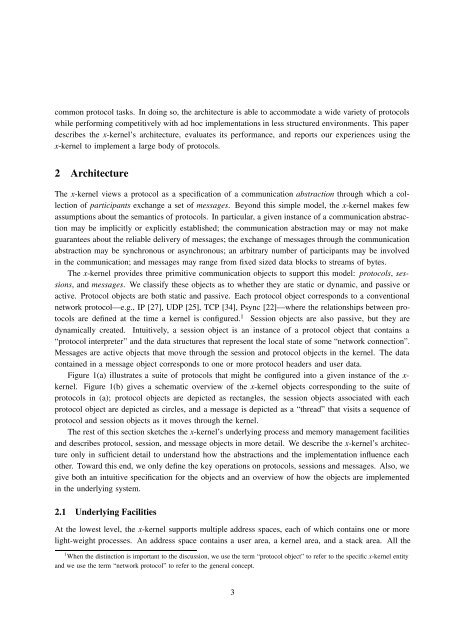The x-Kernel: An architecture for implementing network protocols - IDA
The x-Kernel: An architecture for implementing network protocols - IDA
The x-Kernel: An architecture for implementing network protocols - IDA
Create successful ePaper yourself
Turn your PDF publications into a flip-book with our unique Google optimized e-Paper software.
common protocol tasks. In doing so, the <strong>architecture</strong> is able to accommodate a wide variety of <strong>protocols</strong><br />
while per<strong>for</strong>ming competitively with ad hoc implementations in less structured environments. This paper<br />
describes the x-kernel’s <strong>architecture</strong>, evaluates its per<strong>for</strong>mance, and reports our experiences using the<br />
x-kernel to implement a large body of <strong>protocols</strong>.<br />
2 Architecture<br />
<strong>The</strong> x-kernel views a protocol as a specification of a communication abstraction through which a collection<br />
of participants exchange a set of messages. Beyond this simple model, the x-kernel makes few<br />
assumptions about the semantics of <strong>protocols</strong>. In particular, a given instance of a communication abstraction<br />
may be implicitly or explicitly established; the communication abstraction may or may not make<br />
guarantees about the reliable delivery of messages; the exchange of messages through the communication<br />
abstraction may be synchronous or asynchronous; an arbitrary number of participants may be involved<br />
in the communication; and messages may range from fixed sized data blocks to streams of bytes.<br />
<strong>The</strong> x-kernel provides three primitive communication objects to support this model: <strong>protocols</strong>, sessions,<br />
and messages. We classify these objects as to whether they are static or dynamic, and passive or<br />
active. Protocol objects are both static and passive. Each protocol object corresponds to a conventional<br />
<strong>network</strong> protocol—e.g., IP [27], UDP [25], TCP [34], Psync [22]—where the relationships between <strong>protocols</strong><br />
are defined at the time a kernel is configured. 1 Session objects are also passive, but they are<br />
dynamically created. Intuitively, a session object is an instance of a protocol object that contains a<br />
“protocol interpreter” and the data structures that represent the local state of some “<strong>network</strong> connection”.<br />
Messages are active objects that move through the session and protocol objects in the kernel. <strong>The</strong> data<br />
contained in a message object corresponds to one or more protocol headers and user data.<br />
Figure 1(a) illustrates a suite of <strong>protocols</strong> that might be configured into a given instance of the x-<br />
kernel. Figure 1(b) gives a schematic overview of the x-kernel objects corresponding to the suite of<br />
<strong>protocols</strong> in (a); protocol objects are depicted as rectangles, the session objects associated with each<br />
protocol object are depicted as circles, and a message is depicted as a “thread” that visits a sequence of<br />
protocol and session objects as it moves through the kernel.<br />
<strong>The</strong> rest of this section sketches the x-kernel’s underlying process and memory management facilities<br />
and describes protocol, session, and message objects in more detail. We describe the x-kernel’s <strong>architecture</strong><br />
only in sufficient detail to understand how the abstractions and the implementation influence each<br />
other. Toward this end, we only define the key operations on <strong>protocols</strong>, sessions and messages. Also, we<br />
give both an intuitive specification <strong>for</strong> the objects and an overview of how the objects are implemented<br />
in the underlying system.<br />
2.1 Underlying Facilities<br />
At the lowest level, the x-kernel supports multiple address spaces, each of which contains one or more<br />
light-weight processes. <strong>An</strong> address space contains a user area, a kernel area, and a stack area. All the<br />
1 When the distinction is important to the discussion, we use the term “protocol object” to refer to the specific x-kernel entity<br />
and we use the term “<strong>network</strong> protocol” to refer to the general concept.<br />
3

















